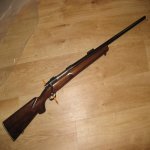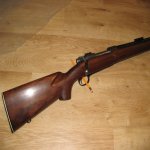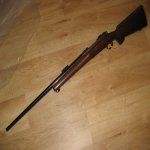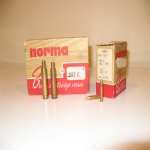The 257 Condor cartridge is really nothing more than a slightly-shorter .257 Weatherby Magnum. The case has just about identical configuration and capacity to those of the more usual magnums of similar case length--the .257 Wby Mag., .264 Win. Mag., and 7mm Rem. Mag. According to P. O. Ackley, 257 Condor cases can be made by necking down 7x61 S&H cases, and this would suggest that the case is slightly shorter and has slightly less capacity than the standard magnums mentioned. I think that if I were forming new cases, I'd probably go with .264 Win. Mag. cases necked down and trimmed to the right length. After fire-forming, they should be fine. Most of the information in the brief article Blastattack cites is pretty pretty run-of-the-mill for any wildcat, including the shoulder configuration which sounds very similar to the double-radius shoulder of the Weatherby Magnums. About all that distinguishes it from the .257 Wby Mag. is that it was designed to shoot very-long .25 caliber hunting bullets (160-grain), and, consequently, any rifle chambered for this cartridge must have a very-fast twist barrel--something like the 1:6 or 1:7 twist cited in the article. For what it's worth, Ackley lists 1:7 as the standard twist.
Wjklassen, have you determined the barrel twist? It would be interesting to know that. And it would be interesting to know how it does with the usual obtainable 115- to 120-grain .257 caliber hunting bullets. Will they be too over-stabilized to shoot well? Berger makes a long .25 cal. 135-grain VLD target bullet that requires a 1:8 twist, and you might try some of these in your new rifle.
The article cited above in Post #2 comes across as a rather strange read, although this may be due to the fact that it was written in 1960, before much of the current knowledge about wildcatting was available. The cartridge is presented as some kind of amazing development (and maybe in 1960 it seemed so) by something of a ballistic genius, one Ramon Somavia, that required "copyrighting" and "may be used only under license," when, in fact, it is just another wildcat that won't do anything any other magnum-size .25 cal. wildcat won't do. In fact, someone with a .257 Wby Mag. action could screw a 1:6 or 1:7 twist barrel onto his action and have virtually the same thing, but what would be the point since 150- and 160-grain .25 caliber hunting bullets just aren't available the last time I looked, the heaviest being 120 grains.
There have been other wildcat .25 cal. magnum cartridges that are for all intents and purposes identical to the 257 Condor--the .25 ICL Magnum and the .257 Baker Magnum, for example, both on a necked-down .264 Win. Mag. case. These and the 257 Condor are discussed in Ackley's two-volume
Handbook for Shooters & Reloaders. In addition, Ackley mentions the 258 Condor, also designed by the same Ramon Somavia who designed the 257 Condor. The 258 Condor case was a blown-out, necked-down .300 H&H case and so longer and of greater capacity than the 257 version.
Not meaning to sound negative here, wjklassen, and I hope you enjoy shooting your new, and very rare, rifle. It should be fun trying out different hunting bullets, and I'd suspect that those in the 115- to 120-grain range will shoot best. If reloading, I'd start with starting loads (or, better, slightly below) for the .257 Wby Mag. in the various loading manuals. It would be great if you could post a picture or two of the rifle. Pictures are always welcome on this forum!















































































